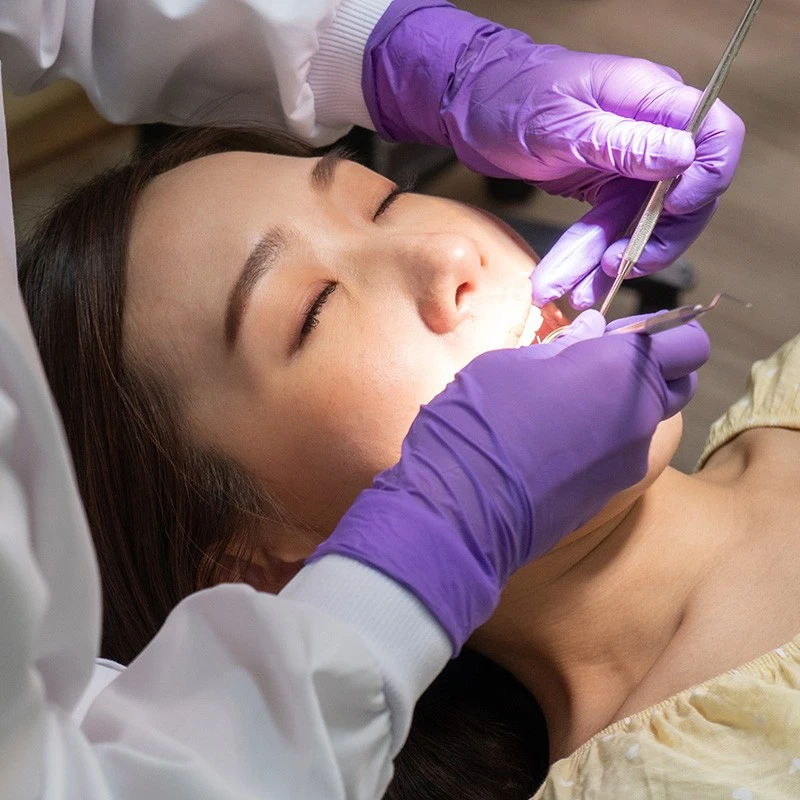
Scaling away tartar and root planning
Scaling is a dental procedure that removes plaque and bacteria from the tooth surface. which causes tooth decay, bad breath, tooth stains, and gum disease, which can lead to other dental diseases. Therefore, scaling is a very important part of dental treatment. Most dentists recommend regular scaling. For oral health and strong teeth
Plaque that is stuck on your teeth. Caused by microbial plaque or food scraps that accumulate between the teeth because they are areas that cannot be cleaned thoroughly. These stains will catch germs. Until it precipitates and becomes a solid on the tooth surface and in the crevices of the teeth, it is a source of germs and bacteria, which is an important cause of many gum and tooth health problems.
What is scaling?
What is scaling? To remove tartar from the mouth, the dentist will use a special tool for scraping away tartar. There are steps as follows:
- Dentist diagnosis to determine how much tartar there is, whether there is tooth decay or other oral problems, in order to evaluate treatment
- Scrape away the tartar and clean. The dentist will use a high-frequency instrument to remove plaque that clings to the tooth surface, neck, between the teeth, and under the gums. After that, use a small piece of tartar scraping equipment. To remove tartar stains with precision again.
- Dental polishing: The dentist will polish the surface of your teeth to make them smooth. which, in addition to being able to help make teeth look more beautiful and shiny, It also helps with food stains. Bacteria and tartar Can also be more difficult to adhere to. Therefore, it is another way to easily reduce the occurrence of dental problems.
- Fluoride coating After scaling and polishing teeth To help prevent tooth decay
Does scaling away tartar take a long time?
Normal scaling takes approximately 45 minutes to 1 hour, depending on the amount of tartar. and the arrangement of each person's teeth.
Scrape off tartar and make your teeth whiter.
Scaling can help whiten your teeth. This is because scaling helps remove tartar, plaque, microorganisms, and food and drink stains that have been stuck on the tooth surface for a long time. These stains cannot be removed with normal brushing. The dentist must use a high-frequency scaling machine. Get rid of these stains.
And for those who smoke or do you like to drink tea or coffee in life? We recommend using Airflow (a dental innovation that uses the energy of water, air, and a small abrasive powder) to remove stains. and deep stains on the tooth surface that come from drinks or cigarettes.
Root planning
Root planning and scaling It removes plaque stains, or tartar, from the tooth area and under the gum seam using medical equipment. It is the primary method for treating gingivitis and dental pulp. In addition to helping treat inflammation of the gums, It also helps maintain other dental health as well.
Root planing is the removal of plaque, tartar, and microorganisms. that accumulates deep in the tooth root surface below and inflamed tissue deep under the gums Most of the time, you'll have to start by scraping off all the tartar from the top. After that, you'll use medical tools. To be used to scrape off the remaining tartar. and scaling the tooth roots under the gums Most root canal scaling must be done with anesthesia. (Because it will be very painful.) In addition to root planing, it will treat inflammation of the gums. It also helps preserve other periodontal organs, such as the tooth root enamel (Cementum), the periodontal ligament (Periodontal Ligament), and the bone in the tooth socket (Socket).
Tooth root grinding process
- Dental X-rays will be taken to assess the severity of the disease.
- Oral cleaning and teeth initially by scraping off tartar to remove tartar and plaque on the teeth and around the gum edge
- Root canal scaling may require anesthetic injections. And scrape each section or half of your mouth at a time. It is a treatment that uses precision. The treatment cannot be completed in one session.
- In cases of severe periodontal disease, surgery to open the gums is required. to treat This depends on the dentist performing the treatment.
- After completing treatment with root planing, there must be regular follow-up on treatment results to ensure oral health. Are your gums better?
Care after root canal surgery
- After root canal scaling in some patients, there may be tooth sensitivity from root scaling. It is recommended to use toothpaste that reduces tooth sensitivity.
- Keep your mouth clean. and teeth regularly. Brush your teeth at least twice a day, use dental floss, and use mouthwash. To reduce tartar formation
- After treatment, you can eat normally. You should eat soft, not too spicy, not too hot food.
- Make an appointment to check your oral and dental health at least once every six months.
Possible side effects of tooth grinding
- Tooth sensitivity may be experienced after root planing treatment. and will disappear by itself, or the patient may use toothpaste that helps relieve tooth sensitivity as well.
- After root canal surgery, there may be some bleeding during the first day. It is recommended to bite on gauze. and rinse with salt water.
- There is a feeling that your teeth are loose after having your new roots polished, but don't worry. After that, you will feel that your teeth are gradually getting tighter.
What is the difference between scaling and root planing?
Scaling
Scaling is the removal of tartar that has accumulated above and below the gums. Scaling involves using a tartar scraper. Normally, anesthesia is not used for scaling. Because it is not a procedure that causes pain. But there will only be tooth sensitivity. and only a slight pain in the gum area. It doesn't take long for it to heal. and the treatment can be completed in one session.
Root Planing
root planing It is the removal of tartar that is on the surface of the tooth root. and deep under the gums. By scaling the roots of the tooth, the treatment must be done more than once, and the patient's condition must be monitored to see if the cleaning has been done correctly or not. What are your symptoms after root canal treatment? Therefore, root planing treatment will be more expensive than root planing treatment.

